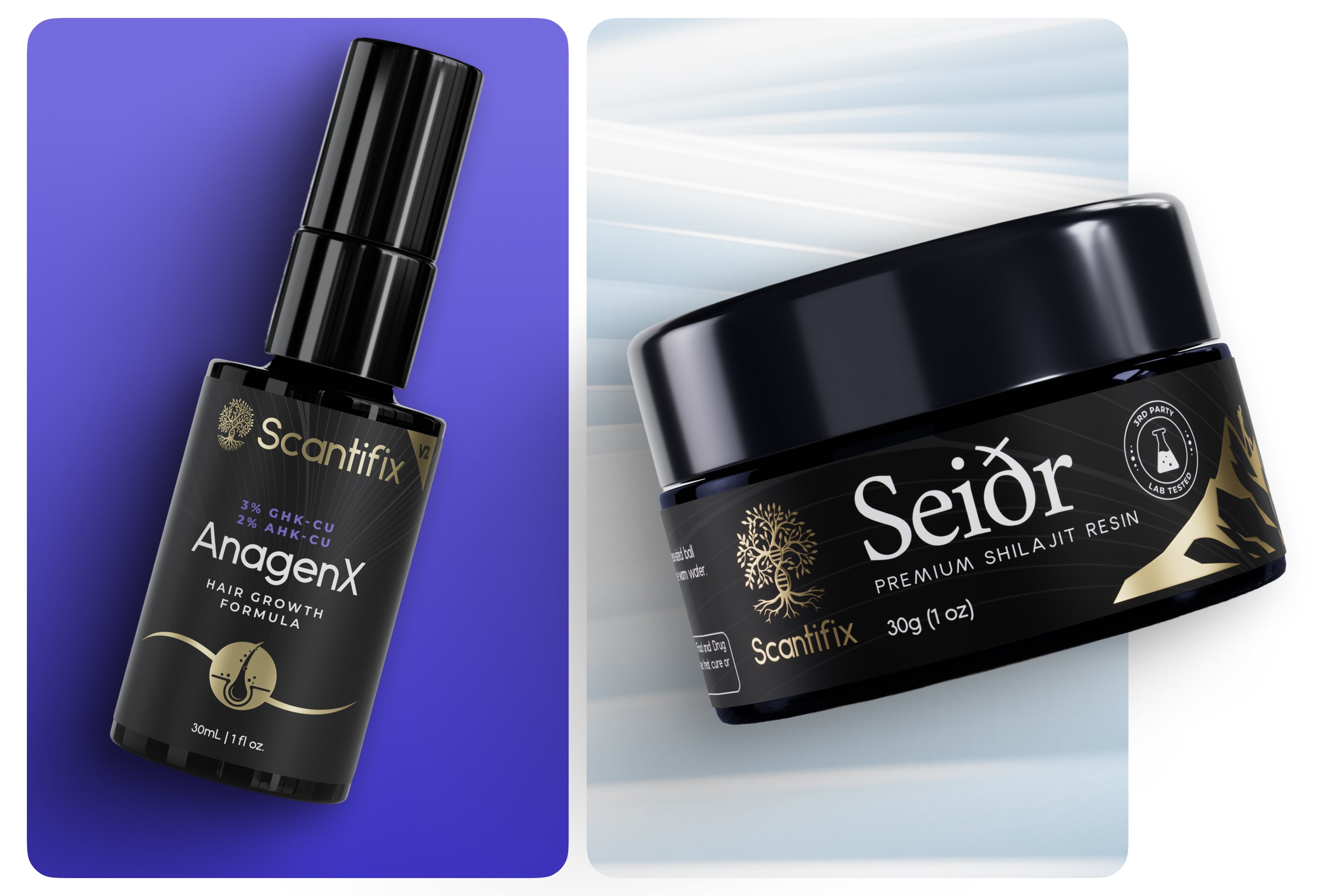Hair loss can be a personal, frustrating, and emotional experience often complicated by conflicting information and one-size-fits-all solutions. But what if much of what we’ve been led to believe simply isn’t true?
This guide is here to separate fact from fiction. Backed by research and rooted in hair loss science, we’ll explore the hair loss myths that still dominate the conversation, and the evidence-based approaches that are truly worth your time.
Hair loss is purely genetic.
MYTH.
While genetics certainly influence hair loss, they don't tell the complete story. Your environment and lifestyle choices play a meaningful role in how those genes express themselves. Research shows that factors like stress, smoking, and overall health all impact your hair patterns (Gatherwright et al., 2012; Gatherwright et al., 2013). Most telling is that even genetically identical twins may manifest different degrees of hair loss. This means you're not powerless—your choices can significantly influence your outcome.
Wearing hats can cause baldness.
MYTH.
The idea that headwear suffocates your scalp and kills follicles has no basis in science. Hair follicles receive nutrients and oxygen through the bloodstream, not the air, so wearing a hat won't interfere with hair growth. At most, tight hats worn constantly could cause minor breakage. But that’s not true follicular hair loss. If you've ever wondered, "Does wearing hats cause baldness?" the answer is a definitive no.
Non-surgical hair growth treatments don’t work.
MYTH.
Non-invasive treatments do work for many people and they’re supported by real science. Topical peptides like GHK-Cu and GHK-Biotin have shown promise in early studies for supporting follicle repair and stimulating new growth through copper delivery and cellular signaling (Pickart, 2008). Similarly, red light therapy is believed to work by improving blood flow and follicle metabolism. In a clinical trial, participants using red light therapy experienced significantly more hair growth than those not using the treatment (Lanzafame et al., 2013). These two examples show that science-backed treatments can effectively support hair follicle health and promote regrowth without the need for invasive procedures like surgery.
Stress causes hair loss.
FACT.
High stress can trigger telogen effluvium, where more follicles than normal enter the resting phase, leading to noticeable shedding weeks or months later. The stress response also elevates cortisol and inflammatory cytokines, disrupting the normal hair cycle (Hughes et al., 2024). If chronic, stress can also impact nutrient absorption and hormonal balance, compounding the effect. So, does stress cause hair loss? The evidence is clear: chronic stress can absolutely disrupt the growth cycle.
Testosterone causes hair loss.
FACT (indirectly).
While testosterone is often blamed for hair loss, it's not the direct cause. Your body converts testosterone into a more potent hormone called dihydrotestosterone (DHT) through the enzyme 5-alpha reductase. It's DHT that actually affects hair follicles in genetically predisposed individuals, causing them to gradually shrink over time (Kinter et al., 2023). This explains why people with 5-alpha reductase deficiency rarely experience pattern baldness despite having normal testosterone levels—understanding this distinction can help guide more targeted treatment approaches.
Overstyling causes permanent hair loss.
MYTH (with nuance).
Heat tools, tight braids or ponytails, harsh chemicals, and even frequent aggressive brushing can cause traction alopecia or shaft breakage. While not the same as genetic or hormonal loss, repeated damage can inflame or scar follicles over time. If detected early, however, this type of loss is usually reversible with proper care.
Hair loss only affects men.
MYTH.
In reality, hair thinning is a common experience for women too. Clinical data show that around 40% of women have visible signs of hair loss by age 50 (Yip & Sinclair, 2015). Female pattern hair loss typically presents as diffuse thinning at the crown or widening of the part line, which are often misattributed to stress or age. Because it progresses more subtly, women’s hair loss is frequently overlooked or misdiagnosed.
Shaving your head makes hair grow back thicker.
MYTH.
This illusion comes from the way hair looks and feels when it starts to grow back, not any real change in follicle activity. The new growth has a blunt edge from being cut or shaved, which can make it seem thicker or coarse, even though the hair itself hasn’t actually changed. Shaving has no effect on the hair shaft’s diameter, growth speed, or density. Follicles continue to function based on internal signals, not haircuts.
Shampoo causes hair loss.
MYTH.
Seeing hair in the drain can be alarming, but it’s usually part of the natural shedding cycle. Most people lose 50–100 hairs per day. While some shampoos may irritate the scalp or dry the hair shaft, they don’t damage the follicle itself. So, does shampoo cause hair loss? The answer is no. Though using non-irritating formulas is still smart for scalp health.
Biotin supplements stop hair loss.
MYTH (unless you’re deficient).
Biotin plays a role in keratin production, but unless you have a clinical deficiency (which is rare), taking more won't reverse hair loss. In contrast, topical peptide technologies like GHK-Biotin work differently by delivering biotin locally alongside copper peptides to support follicle regeneration at the source. This is a critical distinction between oral biotin supplements and targeted peptide-based serums.
Once hair starts thinning, nothing can be done.
MYTH.
This belief prevents people from taking action, and that’s where damage becomes permanent. The truth is, many follicles remain alive but dormant. While no single approach works for everyone, there are a variety of evidence-based treatments available today that can help slow hair loss and support regrowth, especially when started early.
Taking Action: Where Real Results Begin
If you’ve believed some of these myths, you’re not alone. Hair loss misinformation is everywhere, but today we have better tools, better understanding, and better options. The key is shifting from outdated advice and buzzwords to treatments rooted in science.
That’s where our advanced technology and rigorous standards come in. From our red light therapy helmet Dome Beamer to our peptide-enriched topical treatments like AnagenX, we’re building a new standard in hair care that prioritizes transparency, research-backed ingredients, and real biological results.
We don’t rely on hype. We rely on mechanisms that make sense, like delivering active ingredients directly to the follicles, restoring healthy scalp environments, and supporting the entire growth cycle. Whether you’re exploring non-surgical treatments or seeking new answers after years of frustration, we're here to help you take the next step with confidence, clarity, and care.
References:
Gatherwright, J., Liu, M. T., Gliniak, C., Totonchi, A., & Guyuron, B. (2012). The contribution of endogenous and exogenous factors to female alopecia: A study of identical twins. Plastic and Reconstructive Surgery, 130(6), 1219-1226. https://doi.org/10.1097/PRS.0b013e31826d104f
Gatherwright, J., Liu, M. T., Amirlak, B., Gliniak, C., Totonchi, A., & Guyuron, B. (2013). The contribution of endogenous and exogenous factors to male alopecia: A study of identical twins. Plastic and Reconstructive Surgery, 131(5), 794e-801e. https://doi.org/10.1097/PRS.0b013e3182865ca9
Hughes, E. C., Syed, H. A., & Saleh, D. (2024). Telogen effluvium. In StatPearls [Internet]. StatPearls Publishing. https://www.ncbi.nlm.nih.gov/books/NBK430848/
Kinter, K. J., Anekar, A. A., & D'Souza, R. (2023). Biochemistry, dihydrotestosterone. In StatPearls [Internet]. StatPearls Publishing. https://www.ncbi.nlm.nih.gov/books/NBK557634/
Lanzafame, R. J., Blanche, R. R., Bodian, A. B., Chiacchierini, R. P., Fernandez-Obregon, A., & Kazmirek, E. R. (2013). The growth of human scalp hair mediated by visible red light laser and LED sources in males. Lasers in surgery and medicine, 45(8), 487–495. https://doi.org/10.1002/lsm.22173
Pickart, L. (2008). The human tri-peptide GHK and tissue remodeling. Journal of Biomaterials Science, Polymer Edition, 19(8), 969–988. https://doi.org/10.1163/156856208784909435
Yip, L., & Sinclair, R. (2015, July). Female pattern hair loss. DermNet. https://dermnetnz.org/topics/female-pattern-hair-loss





Leave a comment
All comments are moderated before being published.
This site is protected by hCaptcha and the hCaptcha Privacy Policy and Terms of Service apply.